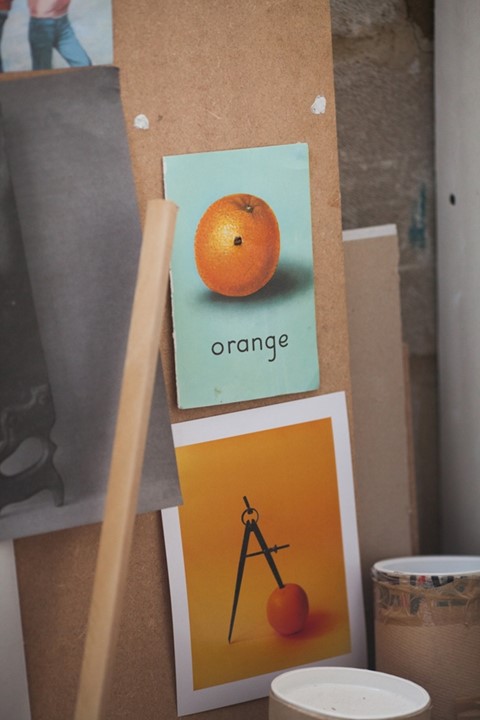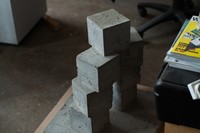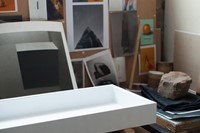Blurring the boundaries between photography and sculpture, Exeter born Darren Harvey-Regan’s work challenges us to scrutinise the divide between an object and its representation...
Blurring the boundaries between photography and sculpture, Exeter-born Darren Harvey-Regan’s work challenges us to scrutinise the divide between an object and its representation. Armed with an MA from the Royal College of Art, and fascinated by the work of heavyweights such as Cy Twombly, John Baldessari and Bill Watterson, the sensitive and mature curation of his exhibitions is integral to the meaning of his work.
The portraits of welded, mismatched industrial tools appear pristine and polished, captured on film like a collection of precious and revered objects. Can you explain how this process started?
This body of work started with Walker Evans’s Beauties of The Common Tool – a commission for Fortune magazine in 1955. The series is a prime example of photography transitioning towards an accepted artform, using the medium to capture the beauty inherent in seemingly banal and commonplace objects. Initially, I’d been making collages of his tool images, but the inevitable next stage was to source matching tools, cut them in half and then rejoin them to emulate those first digital montages. I especially like the reversal of photographic trajectory this entails: photography typically starts with capturing the image of something material, but here I start with pre-existing images and make something physical from them instead. As much as I need to think about the conceptual underpinning of ideas, there’s always a completely subjective investment to the act of making, or finding something to invest feeling and meaning into. The reconfigured tools or painted objects appearing as images: things existing in a type of tension, not solely reducible to the medium you see them in.
"Photography typically starts with capturing the image of something material, but here I start with pre-existing images and make something physical from them instead."
Artists often feel great regret that their final works are somehow still imperfect – you are showing us you are not infallible. What do we gain by coming face to face with these imperfections?
Reality isn’t perfect, but we’ve become accustomed to the digital representations that suggest that it is. There’s the possibility of this phenomena changing our expectations subtly, since in many ways it’s these imperfections that make something attractive or beautiful, tie it to the reality of our lived experience. Photography leans more and more towards the blemish-free, flawless gradients of advertising: an image becomes more about the abstracted ideal, an illustration of a concept. My work is about the materials, and I find it more interesting and intriguing to alter and adapt things, retaining their original properties and appearances – in this way I really feel that image-making is a reciprocal process with the world.
How has your compulsion to collect things influenced your work as a multidisciplinary artist, or informed how you manage to seamlessly curate subject, image and object within the gallery space?
My obsessions as a child typically manifested themselves in collections: of butterflies, fossils, bird sightings, Star Wars figures. It was only during my late teens that I started to appreciate just partially having something, rather than the dogged focus of always having to fully possess it. Many childhood objects and interests have recurred in my recent work, albeit purely unintentionally, and I guess it could stem from a desire to connect to a more stable sense of place and belonging – a simpler, more certain and secure world. I wonder if in some ways, it represents a way of harmonising, or attempting to reconnect with aspects and feelings from the past, evidence of sadness for what I have lost – religious faith, meaning, or love.
It is definitely my intention to create a sense of interest and rhythm, and a sense of tactility where imagery becomes an object and asserts a presence (the books, fossils, magazines). There’s a stripping down of information, a reduction that mirrors the way children’s books present an instructional word or question with its simplest illustration. The curation of the show echoes a focus on looking, a quieter, more spacious and reflective sense.
Will today's generation, used to reading from iPads and kindles, feel the same depth of nostalgic warmth towards the texts and illustrations you use as perhaps we do?
I imagine our nostalgia will only feel richer by virtue of it being ours. Every generation will have things that will no doubt evoke the same feelings in them, and by the time these things are old enough to feel nostalgic, they’ll probably seem more innocent and preferable to whatever’s replaced them. Those of us born during the 70s are probably the last generation with no digital nostalgia, no computers, web, files, video games. I still work primarily with traditional processes because I don’t relate to the immateriality of pixels in the same way I do photographic negatives. I’m unsure of how my work will develop in the long run, and whether this attempt at retaining something tangible is a present fear to work through and be resolved, or to be abandoned completely.
A Shifting Sense of Things runs from 31 January to 8 March 2013 at the Sumarria Lunn Gallery, 36 South Molton Lane, London. W1K 5AB.
Text by Leanne Cloudsdale
Leanne Cloudsdale is a London-based writer. She contributes to titles including AnOthermag.com, Arena Homme Plus, i-D and Inventory.



